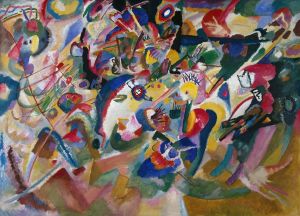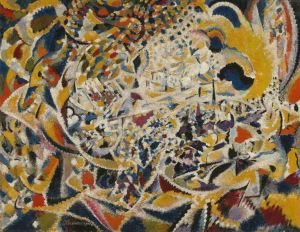
Dancer
A hand-painted replica of Jules Schmalzigaug’s masterpiece Dancer, meticulously crafted by professional artists to capture the true essence of the original. Each piece is created with museum-quality canvas and rare mineral pigments, carefully painted by experienced artists with delicate brushstrokes and rich, layered colors to perfectly recreate the texture of the original artwork. Unlike machine-printed reproductions, this hand-painted version brings the painting to life, infused with the artist’s emotions and skill in every stroke. Whether for personal collection or home decoration, it instantly elevates the artistic atmosphere of any space.
Jules Schmalzigaug (1882–1917) was a Belgian painter known for his association with the Futurist movement, which emerged in Italy in the early 20th century. Schmalzigaug's work is characterized by its dynamic compositions and vibrant use of color, reflecting the Futurist fascination with movement, speed, and modernity. One of his notable works is "Dancer," which exemplifies these qualities.
"Dancer" is a painting that captures the essence of movement and energy, central themes in Futurist art. Schmalzigaug was deeply influenced by his time in Italy, where he encountered the works of prominent Futurists such as Umberto Boccioni and Giacomo Balla. These artists sought to break away from traditional artistic conventions and instead depict the dynamism of the modern world. Schmalzigaug adopted these principles, incorporating them into his own unique style.
The painting "Dancer" showcases Schmalzigaug's ability to convey motion through the use of swirling forms and vibrant colors. The composition is characterized by a sense of fluidity and rhythm, as if the dancer is captured in mid-motion. Schmalzigaug employed bold, sweeping brushstrokes to create a sense of movement, a technique that aligns with the Futurist emphasis on depicting the energy and vitality of life.
Color plays a significant role in "Dancer," with Schmalzigaug utilizing a palette of bright, contrasting hues to evoke a sense of excitement and dynamism. The interplay of colors enhances the feeling of movement, as if the dancer is enveloped in a vibrant aura. This use of color is indicative of Schmalzigaug's broader artistic approach, which often involved experimenting with color theory to achieve a heightened emotional impact.
Schmalzigaug's work, including "Dancer," is notable for its abstraction, a departure from the more representational styles that preceded it. This abstraction allows the viewer to focus on the sensation of movement rather than the specifics of the dancer's form. By doing so, Schmalzigaug aligns with the Futurist goal of capturing the essence of modernity and the fleeting nature of experience.
Despite his relatively short career, Schmalzigaug made a significant impact on the art world, particularly in Belgium, where he is regarded as one of the few artists to fully embrace Futurism. His work, including "Dancer," continues to be studied for its innovative approach to depicting movement and its contribution to the broader Futurist movement.
In summary, "Dancer" by Jules Schmalzigaug is a quintessential example of Futurist art, characterized by its dynamic composition, vibrant use of color, and abstraction. The painting reflects Schmalzigaug's engagement with the themes of movement and modernity, central to the Futurist ethos. Through "Dancer," Schmalzigaug captures the energy and vitality of life, leaving a lasting impression on the art world despite his brief career.


















